
"When black players were released they had few places to go because the Negro Leagues had for all purposes folded. Radio and television did their damage too, and before long barnstorming had faded away also. By the late 1940s, all major league teams had radio stations carrying their broadcasts. By the early 1950s, most major league teams had television coverage. People who could watch major-league baseball on television had no need to go down to their local high school field to see the House of David or the Black Yankees come to town anymore, so the only places for Negro Leaguers to go was Latin America, Mexico or Canada." -- Bruce Chadwick : When the Game Was Black and White
Barney Brown (third from the left above) with the Satchel Paige All-Stars in 1946. Others in the photo, Satchel Paige, Hilton Smith, Howard Easterling, Sam Jethroe, Hank Thompson, Chico Renfroe, Gene Benson, Artie Wilson, Gentry Jessup, Max Manning, Rufus Lewis, Buck O'Neil, Frank Duncan, Quincy Trouppe, and Dizzy Dismukes.
"Once the color line in organized baseball was eradicated, the end of black baseball was inevitable. For all practical purposes, the end of the Negro Leagues came with the stroke of a pen when Jackie Robinson signed a Brooklyn Dodgers contract." -- James A. Riley:The Biographical Encyclopedia of the Negro Baseball Leagues.
Phil Dixon with Patrick J. Hannigan : THE NEGRO BASEBALL LEAGUES A Photographic History
James A. Riley:The Biographical Encyclopedia of the Negro Baseball Leagues
The Negro Leagues Book : Edited by Dick Clark and Larry Lester
BARNSTORMING
Just three years after Jackie Robinson suited up with the Brooklyn Dodgers, dozens of former Negro Leaguers headed for Manitoba and jobs in the new ManDak League. A lone American team, the Minot Mallards joined two Winnipeg teams, the Buffaloes and Elmwood Giants, the Brandon Greys, and Carman Cardinals in the new circuit which began play in 1950.
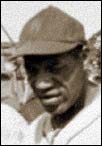 It would be home to many former stars of the now fading Negro Leagues.
It would be home to many former stars of the now fading Negro Leagues.
Willie Wells (left), Leon Day, Lyman Bostock, Ray Dandridge, and Double-Duty Radcliffe were among the players to finish out their careers in Canada. There would be some inter-league play between the ManDak and Western Canada Leagues in the early '50's. In 1959, Williston would join the Western teams in the Canadian-American League.
As the ManDak League began to fade, some of the players drifted West to Saskatchewan and Alberta teams. Barney Brown was one of them.
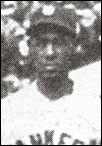
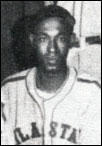
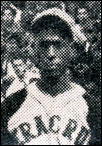
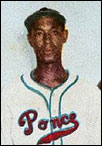
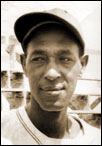

Barney Brown (above, left to right) - 1936 with the New York Black Yankees; in 1944 with the Philadelphia Stars; 1944-45 Veracruz, Mexico; 1950-51 Ponce, Puerto Rico; in Canada in 1955 with the Lloydminster Meridians. Left - me (Harvey Mah, the bat boy) and Brown with Lloydminster in 1956.
Brown was 47 years old when he came to Saskatchewan to pitch for Lloydminster in 1955. While he didn't join the Meridians until the first week of July, the veteran lefty was one of the leagues  top pitchers making eleven starts, all complete games, and finishing with an ERA of 2.90.
top pitchers making eleven starts, all complete games, and finishing with an ERA of 2.90.
Lefty Ted Richardson (right), ace of the 1953 Indianapolis Clowns. Richardson played in the Negro leagues from 1951-55 with the Clowns. In 1955, he was also with the semi-pro St. Joseph Auscos which won the Michigan state title.
He had three years of pro ball in the Detroit farm system beginning in 1956 with Syracuse of the Eastern League, 5-4 2.82. In 1957 had a 10-9 mark with a 2.00 ERA for Orlando of the Florida State League. In 1958, he went 5-1 1.94 for Idaho Falls of the Pioneer League before coming north to play in the Canadian-American League with Lloydminster-North Battleford.
Fellow researcher Gary Fink has compiled a full list (with statistics) of Black players in the ManDak League and has a list of the early pioneers of integration with a list of Black players in organized baseball from 1946 to 1956.
(Photo from Baseball game program for Kansas City Monarchs and Indianapolis Clowns, 1954; Library of Congress; lcweb2.loc.gov/ammem/jrhtml/jr1900s.html)
Negro Leagues / Cuban Connection Page-2 Page-3 Page-4 Page-5 Page-6
